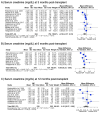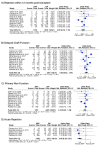Perfusion Techniques in Kidney Allograft Preservation to Reduce Ischemic Reperfusion Injury: A Systematic Review and Meta-Analysis
- PMID: 38929081
- PMCID: PMC11200710
- DOI: 10.3390/antiox13060642
Perfusion Techniques in Kidney Allograft Preservation to Reduce Ischemic Reperfusion Injury: A Systematic Review and Meta-Analysis
Abstract
The limited supply and rising demand for kidney transplantation has led to the use of allografts more susceptible to ischemic reperfusion injury (IRI) and oxidative stress to expand the donor pool. Organ preservation and procurement techniques, such as machine perfusion (MP) and normothermic regional perfusion (NRP), have been developed to preserve allograft function, though their long-term outcomes have been more challenging to investigate. We performed a systematic review and meta-analysis to examine the benefits of MP and NRP compared to traditional preservation techniques. PubMed (MEDLINE), Embase, Cochrane, and Scopus databases were queried, and of 13,794 articles identified, 54 manuscripts were included (n = 41 MP; n = 13 NRP). MP decreased the rates of 12-month graft failure (OR 0.67; 95%CI 0.55, 0.80) and other perioperative outcomes such as delayed graft function (OR 0.65; 95%CI 0.54, 0.79), primary nonfunction (OR 0.63; 95%CI 0.44, 0.90), and hospital length of stay (15.5 days vs. 18.4 days) compared to static cold storage. NRP reduced the rates of acute rejection (OR 0.48; 95%CI 0.35, 0.67) compared to in situ perfusion. Overall, MP and NRP are effective techniques to mitigate IRI and play an important role in safely expanding the donor pool to satisfy the increasing demands of kidney transplantation.
Keywords: antioxidants; in situ cold preservation; ischemic reperfusion injury; machine perfusion; normothermic regional perfusion; organ preservation; static cold storage.
Conflict of interest statement
The authors declare no conflicts of interest.
Figures









References
-
- Bikbov B., Purcell C.A., Levey A.S., Smith M., Abdoli A., Abebe M., Adebayo O.M., Afarideh M., Agarwal S.K., Agudelo-Botero M., et al. Global, Regional, and National Burden of Chronic Kidney Disease, 1990–2017: A Systematic Analysis for the Global Burden of Disease Study 2017. Lancet. 2020;395:709–733. doi: 10.1016/S0140-6736(20)30045-3. - DOI - PMC - PubMed
Publication types
LinkOut - more resources
Full Text Sources
Miscellaneous

